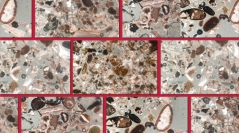

 Geodiversitas
47 (14) - Pages 623-640
Geodiversitas
47 (14) - Pages 623-640The Persian Gulf (PG) being a shallow marginal sea in the northwest Indian Ocean experiences extreme environmental conditions (high seawater temperature and salinity) that impact on bottom sedimentation. To decipher the controlling parameters on sedimentation in the environment of the PG we have used a total of 25 surface sediments and three short cores, 22 coastal sediments as well as water column properties (temperature, salinity dissolved oxygen) and hydrodynamics (current velocity and direction). We applied sedimentological (grain size and type of sedimentary fractions), mineralogical (thin-section, SEM/EDS, XRD, polished-sections), and geochemical analyses (XRF core scanning). The sediments are mainly composed of silt, however sand fraction partially elevates up to around 80% and clay to 10%. Calcium carbonate and organic materials compose up to 18% and 52% of the bulk sediments, respectively. Sea floor surface sediments varies in different fractions, always with high amount of carbonates. Detrital carbonates and aluminum silicate minerals are more common in the beaches and around islands with exposed parent rocks. The core that covers the sedimentation in the Persian Gulf since the end of the Early Holocene encompasses facies representing a higher biogenic carbonate signature in the base, followed by more detrital and organic matter in the middle. Sea level variations are interpreted as the primary driver of such sedimentological variations: periods of high level favored stagnant water conditions and stratification, which allowed to incorporate higher proportion of organic matter in coated grains. Both modern and Holocene sedimentations display strong imprint of basin parameters (mainly water stratification and circulation) in sediment grains and composition. Sediment inputs from the PG catchment led to mixed (in situ biogenic precipitation diluted by detrital supply) sedimentation in the northern part of the PG.
Persian Gulf, sedimentation, carbonate, hypoxia, climate change